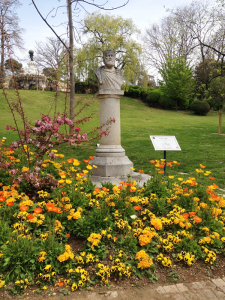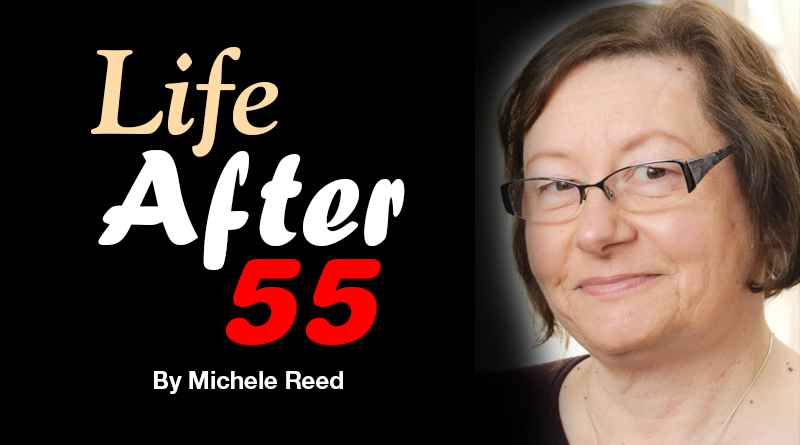A Walk in the Park, with a French Flair
By Michele Reed
michele@cny55.com
Photo by Bill Reed

New York City has its Central Park and Washington, D.C., has The Mall. Here in our adopted city of Béziers, France, we have the Plateau des Poetes, or the Park of the Poets.
This magnificent park links the train station with the Allées Paul Riquet, the pedestrian walkway dedicated to native son Pierre-Paul Riquet, who engineered the Canal du Midi for Louis XIV. As visitors exit the train station, they are met by a huge war memorial sculpted by Béziers artist Jean Antoine Injalbert to honor those fallen in World War I. The monumental sculpture sets the tone for a stroll through a very cultured greenspace with an eye to French history and literature.
Constructed in 1867 and designed in the style of an English garden, the park covers five acres, a sea of green in the middle of the medieval city.
For the city fathers who built it, it was a means to lure visitors to spend some time in the city, rather than hop a train down the line to Nice or Marseille. For us, it means a nearby space to enjoy a bit of nature, when we’re in town to buy cheese, olives and vegetables at the farmers’ market or to do our banking.
The park is an arboretum, home to hundreds of species of plants and trees, all labeled. There is a dovecote and an enclosure for pheasants, but the centerpiece — and my personal favorite — is the swan pond, home to a family of swans, as well as ducks, geese and other waterbirds.
Often we’re there at lunchtime, when we’re treated to an unusual sight. The municipal police patrol the park all day, often in groups of two or three. One policeman spends his lunch hour “walking” one of the swans. He snaps his fingers and the big male swan comes over to the wrought iron fence that marks the perimeter of the pond enclosure. As the policeman strolls along the pathway on the outside of the fence, the swan follows along on his own side of the barrier, sometimes stopping to play a little game. The policeman sticks out his foot while the bird pecks crumbs off the man’s shoes. Once they have made a circuit of the entire pond, and doubled back again, the policeman rewards his feathery friend with a piece of baguette. Then the cop goes back to his patrol of the park.
Peacocks patrol the park, too. We’ve been surprised by their squawking voices, and the sudden sight of them coming around a rhododendron bush. They are beautiful birds, with iridescent feathers of blue and green, but their voices are not so lovely!
All year long, the park sports floral displays, planted and tended by park workers according to the season. The weather here in the south is so mild, that even in winter, some species of plants maintain their flowers.
But the heart of the park, from which it gets its name, are the statues of the poets.
Prominent among them is Victor Hugo, the author of “The Hunchback of Notre Dame,” and “Les Misérables.” The famous French author is surrounded by a small garden of flowers and his statue faces several benches where Béziers residents and visitors share picnic lunches, read books or simply relax, while contemplating the nature and literary figures surrounding them.
Another local poet, Jean Laurés, was a poet of the people. A farmer, he worked on the land during the day, and wrote his poetry at night.
A new section of the park focuses on modern poets. I was pleased to find a woman author represented. Jeanne Barthes founded a literary review in the late 1930s and ’40s, and wrote sketches, comedies and dramas in the local language of Occitan.
Dominating the skyline of the park, and visible from most of its walkways, is a huge fountain, The Titan by Injalbert. It is topped with a statue of Atlas holding up the world, and from its base, decorated with statues of Poseidon and his daughter, a nymph, flow streams of water, cascading in mini-waterfalls to the swan pond below.
Where the park joins the heart of the city, the current administration has invested in even more reasons to keep visitors enjoying the centre-ville. This year, they erected Le Grand Roux, or the big wheel, a 100-foot-tall Ferris wheel, with views of the entire valley of the Orb River.
Nearby, a series of jets spring up from the ground, accompanied by a light show and music at night, providing warm weather amusement for tourists and a never-ending source of fun for local children.
On the day before we left to return to Oswego, we strolled through the park, enjoying the swans and sculptures and ending up at our favorite café for a glass of rosé (served the French way, with ice cubes), to toast a speedy return to our adopted home.
Editor’s Note: 55 PLUS columnist Michele Reed has a story included in the new Chicken Soup for the Soul book: “Life Lessons from the Dog.” The piece — “The Hot Dog Thief” — tells the story of Reed and husband Bill’s son›s rescued hound, Jerome, whose love of cured meats led him to a life of thievery. A portion of the proceeds is donated to American Humane and the book is available at the river’s end bookstore in Oswego as well as online.

